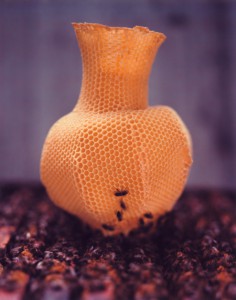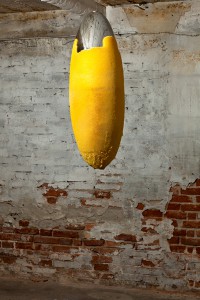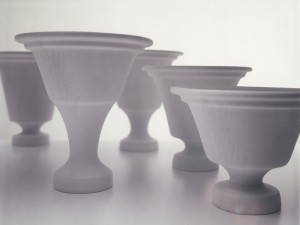I have always been fascinated by different kinds of materials and combinations of them as there are thousands of different possibilities of the outcome. And especially in art or design works where you can feel that the material was completely ‘understood’ by it’s artist or designer. It was exactly that feeling that I got when I saw Tomas Gabdzil Libertiny’s Honeycomb Vessel #2 in the Boijmans van Beuningen Museum in Rotterdam.
The Paper Vase or the Honeycomb Vases demonstrate a new way and approach of working with materials. This means that natural processes have to be understood and investigated from all different kind of perspectives. I like this thought and I think it is a crucial one for ‘sustainable’ design. We should communicate with our environment and understand it. Therefore it is important to take advantages of the things that are already there. The Honeycomb Vases symbolize this crucial understanding. In collaboration with beekeepers he found a way to make the bees build a vase like shape. The vases are created by placing a basic beeswax mould printed with a honeycomb pattern into a beehive. The bees then start to work with that pattern. It took 40,000 honey bees that worked over a course of one week to create one vessel! Libertiny himself calls this process ‘slow prototyping’. Every vessel has a unique form and they also vary in color and smell depending on the flowers that are in season.
The Honeycomb Vases were his graduation work for his master at the Design Academy in Eindhoven. It all started in 2006 with the starting point to choose one material, without an idea of a form or concept. It was all about the material, to completely understand it and to come to a really close connection to what it is and what it means. Libertiny rejected everything else that is connected with industrial design as we know it (like plastics, stainless steel, aluminum etc.). He wanted to use something that is very ordinary yet very fragile, non functional and non usable. This is how he got to work with wax. The breaking point in this project was the question: ‘What if I make an object of wax where the material is already being made’. And this is were the bees came in.
On Dezeen I found this quote by Tomas Libertiny:
I have been interested in contradicting the current consumer society (which is interested in slick design) by choosing to work with a seemingly very vulnerable and ephemeral material – beeswax. To give a form to this natural product it has occurred more than logical to choose a form of a vase as a cultural artifact. Beeswax comes from flowers and in the form of a vase ends up serving flowers on their last journey.
At this point I asked myself a question: “Can I make this product already at the place where the material originates?” My ambition to push things further led me to alienate the process by which bees make their almost mathematically precise honeycomb structures and direct it to create a fragile and valuable object – like a pearl. This takes time and time creates vault.”
Tomas Libertiny considers design to be a matter of strategy. It makes sense as design has the purpose to convey a task; it is supposed to perfectly adapt and adjust to it’s environment and it’s people around it. And when we look at design and nature then everything is designed through evolution. Constant changes force all kinds of constellations and materials to adapt to ever changing surroundings (especially in this time). The best strategy wins but doesn’t mean to be the ultimate solution; it will always change again.
But where does Libertiny’s work stand? Is it more art than design?
The objects might be functional and wonderfully designed but the choice of the material gets rid of its function at the same time. A paper or wax vase filled with water would not work out the way we want it to. The contrast between function and material is contradictory; the character of the material would not necessarily fit the function.
Libertiny’s work The Seed of Narcissus is a good example for the choice of materials. The choice of glass and beeswax couldn’t be more contradictory. On the one hand there is glass as a material that is mainly used in industrial productions; it is hard and very resistend to heat – and on the other hand there is beeswax which is a result of a completely natural process; it is fragile and not resistend to heat. The only thing they have in common is their fragility.
I myself understand designers not to invent something new but to communicate something that already exists. Therefore design has to be understood whereas art can be interpreted; good design should send the same message to everyone whereas art can send a different message to everyone. You can have an opinion about design but taste about art. Tomas Libertiny himself describes his work to be in-between industrial design and sculpture.
Tomas Gabzdil Libertiny first studied industrial Design in Slovakia but started to study at the University of Washington where he explored sculpture and painting. Afterwards he studied painting and conceptual design in Bratislava. In 2006 he received his master at the Design Academy Eindhoven. This background explains his technical understanding and his relation to nature by using it as a means to understand industrial production, methods, hierarchy and structure and furthermore his interest to combine industrial materials with very ordinary and natural ones.
In 2009 he was awarded ‘The Designer of The Future’ award during Art Basel.
If you are interested in more background on Libertiny view the interview on Designblog Alex Mercer made of him in the context of “the designer as artist” project March 2011




